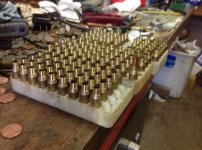jackie schmidt
New member
I switched back over to a .269 neck this past week, decided to turn the necks on all of the 274 no neck turn necks I had that had just been fired a couple of times. I will try to post a quick video of my Lathe set-up that allows me to turn a neck at a rate of about 30 seconds each.
http://benchrest.com/attachment.php?attachmentid=16126&stc=1&d=1430055415
http://benchrest.com/attachment.php?attachmentid=16126&stc=1&d=1430055415







